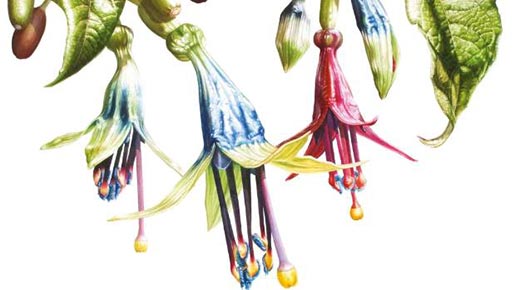First published in NZ Gardener magazine’s March 2018 issue; and Stuff.co.nz, 30 March 2018
Originally written for NZ Gardener magazine
Nearly everyone has a camera with them in their phone these days, so it may be hard to imagine an era when botanical artists were important members of any voyage of exploration.
Yet, in the 18th and 19th centuries, they had the crucial tasks of categorising and recording the exotic flora of the New World. Through them, fabulous plants – meticulously executed in all their exotic strangeness – fired the imagination of garden lovers and scientists alike.
Strongly motivated by the financial imperative, expedition leaders such as Captain James Cook continually sought plants of potential economic importance.
By the late 18th century, botanical paintings by artists such as Sydney Parkinson, who illustrated many of the plants botanists Sir Joseph Banks and Daniel Solander discovered during James Cook’s first voyage to the Pacific in 1768, had awakened intense interest in New Zealand flora.
In later years, enthusiasm for New Zealand plants was fuelled by Joseph Hooker’s Flora Novae-Zealandiae and the Handbook of New Zealand Flora, both of which featured works by Scottish botanical illustrator Walter Fitch. By the time the settlement of New Zealand began in earnest, botany was soaring in popularity in Britain.
As plants from throughout the world were brought back to the “home country”, and cultivated for garden and commercial use, the artists who could render them with faithful accuracy were in constant demand.
Although most of the early botanical artists (and certainly all those sent on voyages of exploration) were men, women became increasingly significant in this genre. Flower painting was considered to be a particularly desirable accomplishment for ladies, especially those who aspired to some form of gentility.
When in Britain or continental Europe, these lady artists painted familiar flowers from their gardens and countryside, be they daffodils, bluebells, trees in blossom or the treasures of the hedgerows. In New Zealand, they used their talent to capture both the beauty and the scientific details of the native wildflowers that grew around them.
Martha King, who arrived in Wellington in 1840, travelled to Wanganui where she, older sister Maria and brother Samuel lived in a tent before taking up residence in a raupō whare. Unbothered by the lack of the most basic amenities, Martha soon put paintbrush to paper and produced the first botanical paintings by a resident New Zealand artist.
Although her entire body of work was very small (it fits into just one box in the Alexander Turnbull Library in Welllington) the inclusion of some images in Edward Jerningham Wakefield’s Adventure in New Zealand guaranteed a degree of immortality.
Botanical painting could be a surprisingly liberating occupation for the women of early New Zealand. Some lady painters took to their painting with such skill and style that their art even became a financially rewarding occupation. Although many were from an artistic background, others were mainly self-taught, which made their achievements even more remarkable. Attractive presentation was necessary to ensure sales, but technical accuracy was essential if the work was to be respected in scholarly circles.
Always admiring of the plants and flowers that they painted, many of the artists also had a deep interest in botany. When Gisborne settler Sarah Featon was working on The Art Album of New Zealand Flora, she invariably painted with her copy of Hooker’s Flora by her side, intent on ensuring that every detail was as accurate as could possibly be.
Flower painting also gave these women an excuse for expeditions that may not otherwise have been approved of. Painting trips into the New Zealand back country were considered respectable because the women were searching for exotic and rare botanical specimens to paint.
Ironically, this enthusiasm for painting native New Zealand plants came at a time when many New Zealand gardeners were only interested in introducing “foreign” plants to their newly established gardens and had little regard to growing, or even saving, native plants threatened by development.
It was not until 1924, with the publication of Leonard Cockayne’s Cultivation of New Zealand Plants, that native trees and shrubs were finally and truly appreciated.
This passion for painting beautiful and exotic specimens of plants and flowers has continued into the 20th and 21st centuries.
In the wake of Thomas Cheeseman’s Illustrations of New Zealand Flora (1914), many remarkable botanical artists, including Nancy Adams, Audrey Eagle and Brian Poole, have produced work of great beauty and technical accuracy.

Acclaimed botanical artist Bryan Poole, formerly of Invercargill, now of Hackney, London with his etching of a pineapple at his 2017 exhibition. Photo by Marjorie Cook.
Botanical art has become a fine and enduring tradition here, and the Kiwi artists carrying the torch include London-based Bryan Poole, Denise Ramsay who divides her time between Hong Kong and France, and Wellington-based Sue Wickison, who regularly works with the Royal Botanic Gardens, Kew.
Note: To see more, the World Wide Exhibition for Botanical Art opens at the Auckland Botanic Gardens on March 30. The exhibition then travels to Wellington Botanic Garden (August 1-September 9) and Millennium Gallery in Blenheim (November 3-December 9).

